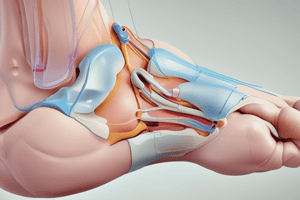Podcast
Questions and Answers
What is Hallux Limitus?
What is Hallux Limitus?
Decreased range of motion of 1st MPJ of less than 65° in the sagittal plane, painful.
What is Hallux Rigidus?
What is Hallux Rigidus?
Absent motion of the 1st metatarsal phalangeal joint.
How much dorsiflexion is required for normal gait?
How much dorsiflexion is required for normal gait?
65°-75°
What defines Functional Hallux Limitus?
What defines Functional Hallux Limitus?
What causes Structural Hallux Limitus?
What causes Structural Hallux Limitus?
Match the following Hallux Limitus classifications with their descriptions:
Match the following Hallux Limitus classifications with their descriptions:
What are the common conservative treatments for Hallux Limitus/Rigidus?
What are the common conservative treatments for Hallux Limitus/Rigidus?
What is the goal of Joint Salvage Procedures for Hallux Limitus?
What is the goal of Joint Salvage Procedures for Hallux Limitus?
What is the most common joint salvage procedure?
What is the most common joint salvage procedure?
Flashcards are hidden until you start studying
Study Notes
Hallux Limitus and Rigidus Definitions
- Hallux Limitus involves decreased range of motion of the first metatarsophalangeal joint (MPJ) to less than 65° in the sagittal plane, resulting in pain.
- Hallux Rigidus is characterized by absent motion at the first MPJ.
Normal Gait Requirements
- Normal gait requires dorsiflexion of 65°-75° at the first MPJ.
Types of Hallux Limitus
- Functional Hallux Limitus presents decreased MPJ motion under load, often showing pain or limited motion in weightbearing stance, and responds well to orthosis.
- Structural Hallux Limitus demonstrates decreased hallux motion regardless of foot loading, often due to bony overgrowth or loss of joint surface.
Etiology of Hallux Limitus/Rigidus
- Contributing factors include a long or immobile first ray, 1st ray elevatus, degenerative joint disease (DJD), septic arthritis, systemic arthritides, trauma, and sometimes iatrogenic causes.
Regnauld Classification of Hallux Limitus
- Grade I: Functional limitations and mild dorsal spurring without structural sesamoid disease.
- Grade II: Features a broad, flat metatarsal head with narrow joint space and sesamoid hypertrophy.
- Grade III: Severe joint space loss, extensive spurring, and osteochondral defects.
Olaff Jacobs Classification Stages
- Stage 1: NWB less than 65° and WB less than 30° dorsiflexion; pain during ROM without crepitus.
- Stage 2: NWB ROM < 50-64° and pain with ROM; mild degenerative changes.
- Stage 3: NWB ROM < 30-45° and pain with crepitus; moderate degenerative changes.
- Stage 4: NWB ROM < 20°; absent ROM on WB, pain, crepitus, and severe degenerative changes.
ACFAS Classification of Hallux Limitus
- Grade 1: Biomechanical imbalance with metatarsal elevation but no joint disease.
- Grade 2: Early disease with dorsal spurring.
- Grade 3: Moderate disease indicated by spur formation and joint space narrowing.
- Grade 4: End-stage condition.
Clinical Presentation of Hallux Limitus/Rigidus
- Symptoms include joint pain with palpation and ROM, palpable exostosis, 1st ray elevation, metatarsalgia, and signs of arthritis.
Radiographic Findings
- Common findings include flattening of the first metatarsal head, dorsal exostosis, joint space narrowing, and the presence of loose bodies.
Conservative Treatment Options
- Non-steroidal anti-inflammatory drugs (NSAIDs), injections, physical therapy, and orthosis like Morton's extension are recommended.
Surgical Considerations
- Joint salvage treatments apply to Hallux Limitus stages 1-3, aiming to alleviate pain, regain motion, and ensure long-term results. Joint destruction is indicated for Hallux Rigidus.
Joint Salvage Procedures
- Cheilectomy: The most common procedure involving shaving off bone and removing dorsal exostosis.
- Austin procedure: Shortening osteotomy balancing metatarsal shortening with slight dorsiflexion.
- Hohmann: A trapezoidal wedge method, less frequently utilized.
- Waterman: Dorsiflexory wedge procedure that protects the sesamoids; modifications allow for greater correction.
Miscellaneous
- Kessel and Bonney procedure: Focuses on a dorsiflexed hallux, refining the understanding and treatment approaches for hallux conditions.
Studying That Suits You
Use AI to generate personalized quizzes and flashcards to suit your learning preferences.




